|
|
|
Sort Order |
|
|
|
Items / Page
|
|
|
|
|
|
|
| Srl | Item |
| 1 |
ID:
177553
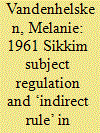

|
|
|
|
|
| Summary/Abstract |
This paper discusses the principles behind the 1961 Sikkim Subject Regulation, the first citizenship law framed in Sikkim. It explores the historical construction of the entanglement of ‘ancestrality’ with land property and political membership, which is central to the issue of citizenship in Sikkim today. It shows how categories of citizens were formed in colonial and post-colonial time, in particular the division between ‘natives’ (Bhutia and Lepcha) and ‘settlers’ (Sikkimese Nepalis). With the revision of the Regulation in 1962, land property and ‘ancestral’ settlement became central criteria to acquire Sikkim Subject status. The paper shows how land property have become a materialisation of belonging to the place, and highlights the inequalities that the dependency created between insidedness and land property engendered. It also argues that a sole analysis of these inequalities in terms of ethnicity is insufficient by showing that other factors have taken part in forming them.
|
|
|
|
|
|
|
|
|
|
|
|
|
|
|
|
| 2 |
ID:
177551
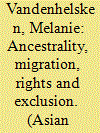

|
|
|
|
|
| Summary/Abstract |
This is the introduction to a special issue of Asian Ethnicity that includes six papers on the issue of citizenship in the Indian state of Sikkim, from the perspectives of anthropology, political science, sociology and history. These contributions explore the entanglement of migration and ethnicity that defines political membership and exclusion in Sikkim, as it does in other parts of India. They give a central place to the consequences of the combination of the 1961 Sikkim Subject regulation (that remained valid after Sikkim became a part of India in 1975) and ‘group-differentiated citizenship’ in a context where Sikkim’s population – formed through people’s mobility within a region that has long been a crossroads between Nepal, Tibet, Bhutan and India – was brought into the frame of a territorial concept of the nation. These papers also explore the means used by people in Sikkim to contest their categorisation by the state.
|
|
|
|
|
|
|
|
|
|
|
|
|
|
|
|
| 3 |
ID:
177558


|
|
|
|
|
| Summary/Abstract |
The outbreak of Covid-19 has been highly racialised and stigmatised around the world based on the origin of the virus and its highly infectious nature. Profiling of Asians or mongoloid looking individuals as a suspect carrier of the virus and the resultant taunts and discriminations occur worldwide. In India, the pandemic has reinforce racism against Northeast Indians, which the country has been grappling with this social problem in the last one decade or so. Such discriminations were overt acts of racial prejudice that primarily stems from the nonrecognition or misrecognition of Northeast Indians, who are mainly mongoloid race, as Indians. During the pandemic, the fight by Northeast Indians was with the mindset of the rest of Indians as much as the virus itself. It was a fight not only against the presumption of being ‘non-Indian’ with negative affiliation, or worse ‘unwanted Indians’, but also to get due recognition and acceptance as equal Indians. The absence of stringent anti-racism laws may have resulted in the pervasiveness of overt acts of racism during the pandemic. However, such actions are best understood on the structural elements that underpin Indian societies. The legal measures to address this social problem will reduce overt acts of racism but addressing covert racial acts, which are structural in nature, is a long way to go.
|
|
|
|
|
|
|
|
|
|
|
|
|
|
|
|
| 4 |
ID:
177554
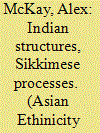

|
|
|
|
|
| Summary/Abstract |
In this article I draw on Robb”s insights (“The Colonial State and Constructions of Indian Identity” Modern Asian Studies, 1997), in discussing how during the British period (1888 to 1918), Indian structures were introduced and established in Sikkim closely following models used in British India. In areas such as law and justice, health, education, taxation and communication systems, Sikkim was structurally aligned with India. In contrast, however, the colonial era processes of national identity construction in Sikkim entirely excluded identification with an Indian Nation. Under the British, Sikkimese identity was constructed as a Tibetan Buddhist state comprising “indigenous” Bhutia-Lepcha citizens. That identity excluded immigrants whose origins were in the Gurkha kingdom. As a result of the social processes that imagined Sikkim as an (independent) Buddhist Nation, none of the ethnic communities in Sikkim identified themselves as “Indian”, leaving Sikkim structurally equipped but socially unprepared for membership of an Indian Nation.
|
|
|
|
|
|
|
|
|
|
|
|
|
|
|
|
| 5 |
ID:
177552
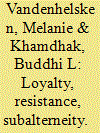

|
|
|
|
|
| Summary/Abstract |
This paper explores the process of construction of the interconnection between ethnicity, indigeneity, and political participation in Sikkim concerning the Limbu ethnic community. It firstly discusses Limbu associations’ claims for the reservation of seats for the Limbu community in the state legislative assembly, following the recognition of the group as a Scheduled Tribe in 2003. From this point on, the paper goes further back in time, and, based on archival documents, shows that the view of the lack of political representation of the Limbu as a result of ethnic discrimination is grounded in a ‘uncertain’ membership, which has historical roots dating back to the foundation of the kingdom. It shows that the troubled relations between the Limbu and the leading power in Sikkim in the early days of the kingdom long continued to inform their subaltern form of political membership.
|
|
|
|
|
|
|
|
|
|
|
|
|
|
|
|
| 6 |
ID:
177559
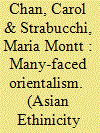

|
|
|
|
|
| Summary/Abstract |
Ethnic Chinese and Asians have historically been excluded, invisibilized, or experienced conditional inclusion in South America. In Chile, the global pandemic provoked an increase in older patterns of anti-Chinese racism and anti-China sentiments. Orientalist and racist discourses have gone uncriticized, although anti-China statements by politicians and academics have provoked diplomatic backlash. Contextualizing the history of orientalism and representations of Chineseness in Chile, we show that dominant political and cultural discourses during COVID-19 strongly reproduce the dichotomy between the ‘Oriental’ and ‘Occidental.’ The pandemic reveals the superficial and problematic nature of the government’s recent attempts to articulate multiculturalism in an era of ‘rise in China’ tropes.
|
|
|
|
|
|
|
|
|
|
|
|
|
|
|
|
| 7 |
ID:
177557
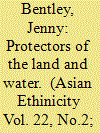

|
|
|
|
|
| Summary/Abstract |
In Sikkim, India, indigenous activists protesting against dams in their reserve, Dzongu, have turned ancestral territorial boundedness into a political resource and asserted that all Lepcha have stakes in Dzongu’s future, reconceptualising citizenship as not defined by the Indian government or the subnational states of Sikkim and West Bengal, but as deriving from the relations of the Lepcha to their ancestral territory that spans present-day borders. I analyse this reconceptualization and the strong local resistance against it along three modalities: the temporality of historical boundedness, the spatiality of the traditional territory, and the polysemy of territorial relations. I conclude that the indigenous cross-border claims failed to be sustained as political action due to the legacy of state institutions as welfare providers, the vulnerability of Sikkimese belonging, and the non-inclusion of local understandings of the sacred Dzongu landscape. This article contributes to the debate on polysemic territoriality, citizenship, resistance and vulnerability.
|
|
|
|
|
|
|
|
|
|
|
|
|
|
|
|
| 8 |
ID:
177556
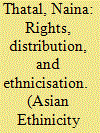

|
|
|
|
|
| Summary/Abstract |
‘Old Settlers’ is a name that people commonly known as ‘Marwari’ and others ‘Sikkimese of Indian origins’ have adopted for themselves following 2008 Amendment 26AAA, which exempted from income tax Sikkim Subject Certificate holders; ‘Sikkim Subject’ status was the form of citizenship granted during the monarchy, and it remained basis of access to citizenship rights after the inclusion of Sikkim into India in 1975. Whereas some of their families had settled in the nineteenth century, which would have qualified them for Sikkim Subject status, Marwaris living in Sikkim were not given this status. Why ‘old settlement’ became central to their claims after 2008? This paper analyses the emergence of label ‘old settlers’ as an outcome of the specific connection in Sikkim between formal recognition as an ethnic minority and distribution of state benefits, and of increased importance given to a territorial form of recognition after 1975.
|
|
|
|
|
|
|
|
|
|
|
|
|
|
|
|
| 9 |
ID:
177555


|
|
|
|
|
| Summary/Abstract |
The paper deals with the empirical category of Sikkim Subject, now a special category of Indian citizens. It traces the path of the citizenship project in Sikkim, which remained insulated from the processes of India’s citizenship regime from 1975. The paper further analyses evolving citizenship discourse from the framework of acquiring citizenship through the incorporation of foreign territories by India after the commencement of the Indian Constitution, 1950, and the Indian Citizenship Act, 1955. One such encounter, the Sikkim Citizenship Order of 1975, highlights the evolving tensions associated with the practical imperatives of Indian citizenship often exacerbated by anti-immigrant movements in parts of North East India. The paper argues that Indian citizenship, liberal in its foundations, which situates individual equality as the unit of citizenship analysis converge with the differentiated model of citizenship with group and community-cultural rights in a historical specificity in Sikkim.
|
|
|
|
|
|
|
|
|
|
|
|
|
|
|
|
|
|
|
|
|